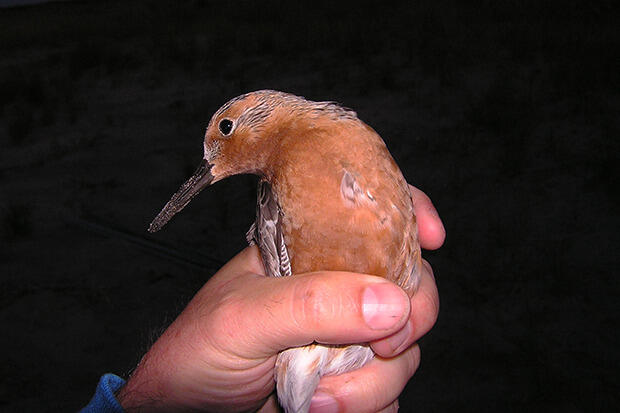
Jan. 5, 2015
In the red: Climate change threatens red knot population
Share this story
In December, the red knot was added to the U.S. Fish and Wildlife Service’s list of endangered and threatened wildlife, making it the first bird whose listing identifies climate change as a principal threat to its survival. In the past 30 years, the small shorebird’s population has declined by more than 75 percent, from almost 150,000 to possibly below 30,000.
“Habitat available to knots is being ratcheted down as we continue to consume the coastline,” said Bryan Watts, director of the Center for Conservation Biology, a unit within the Virginia Commonwealth University Rice Rivers Center. The center operates as a partnership between researchers at VCU and the College of William and Mary.
Since 1994, Watts has worked with Barry Truitt, chief conservation scientist for the Virginia Coast Reserve of The Nature Conservancy, to conduct weekly aerial surveys of shorebirds along the outer coast of Virginia during the spring migration season. Data collected by Watts and Truitt played a significant role in the listing process. “It’s one of the best data sets on a migration area for the population,” Watts said.
Reasons for the red knot’s decline include the loss of habitat, reduced prey availability, and increased mismatches between the annual migratory timing relative to favorable food and weather. Residential and commercial development along the coasts of Delaware, Virginia, North Carolina, South Carolina and Georgia has contributed significantly to the loss of habitat. “They are strictly using the outer coast,” Watts said. “That’s the reason why they’ve been so vulnerable to development.”
Virginia will play a critical role in the stabilization and recovery of red knot, since up to half of the population relies on the Virginia Barrier Islands as a refueling site during their migration from the High Arctic to the tip of South America. Unlike the highly developed coastlines of New Jersey to the north and Georgia to the south, more than 95 percent of the barrier islands are in protective ownership by The Nature Conservancy, the U.S. Fish and Wildlife Service and the commonwealth of Virginia.
“We have this jewel of the barrier islands here in Virginia,” Watts said. “The pristine coastline provides a much-needed oasis for the birds during their northward migration.”
In a forthcoming paper to be published in the Journal of Wildlife Management, Watts and Truitt outline the importance of Virginia for staging red knots and sound an urgent alarm. “[The article] discusses the population decline and the importance of Virginia within the broader context of the Mid-Atlantic,” Watts said.
As restoration efforts progress, the Center for Conservation Biology will continue to provide data and advice to the U.S. Fish and Wildlife Service in the upcoming years. “We will continue to have a monitoring role,” Watts said.
Subscribe for free to the weekly VCU News email newsletter at http://newsletter.news.vcu.edu/ and receive a selection of stories, videos, photos, news clips and event listings in your inbox every Thursday. VCU students, faculty and staff automatically receive the newsletter. To learn more about research taking place at VCU, subscribe to its research blog, Across the Spectrum at http://www.spectrum.vcu.edu/
Subscribe to VCU News
Subscribe to VCU News at newsletter.vcu.edu and receive a selection of stories, videos, photos, news clips and event listings in your inbox.








